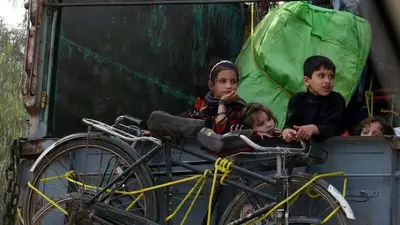World News
Ocean cleanup group removes record 25,000 pounds of trash from Great Pacific Garbage Patch in one extraction
Ocean cleanup crews have fished out the most trash ever taken from one of the largest garbage patches in the world.
The Ocean Cleanup, a nonprofit environmental engineering organization, saw its largest extraction earlier this month by removing about 25,000 pounds of trash from the Great Pacific Garbage Patch, Alex Tobin, head of public relations and media for the organization, told ABC News.
MORE: US produced more plastic waste in 1 year than any other country on Earth: Study
The vessels are currently on the way back to port in Victoria, British Columbia, after having collected about 50 tons of garbage in four weeks, Tobin said.
The Great Pacific Garbage Patch, an enormous pile of floating trash carried by ocean currents and winds to the Pacific Ocean between Hawaii and California, is the largest of the world's five ocean garbage patches.

It is difficult to determine an exact size, as the trash is constantly moving, according to NOAA. The Ocean Cleanup has estimated the Great Pacific Garbage Patch to have grown to twice the size of the state of Texas, Tobin said.
The patch in the Pacific has grown so much that a new coastal ecosystem is thriving on it, a study published by Nature Ecology & Evolution in April found.
MORE: On the remotest of islands, hundreds of tons of plastic and other waste washing ashore: Study
Garbage patches pose dangers to the local ecosystem by entangling marine life in fishing nets, Animals eating plastic and other debris and by transporting non-native species from foreign habitats, according to the National Oceanic and Atmospheric Administration.
It is unclear how garbage patches affect human health, but humans may be exposed to microplastics from a number of sources from the ocean, such as seafood and sea salt, according to NOAA.

It may not be possible to entirely rid the ocean's garbage patches of trash, especially since some of the material will take a long time to break down in the environment, according to NOAA. Plastics may never fully break down.
The Ocean Cleanup's aim is to remove 90% of floating plastic from the oceans by 2040, which they believe is achievable, Tobin said.
MORE: Ocean plastics problem isn't going away, but here's what you can do to help
The nonprofit has a two-pronged approach of removing "legacy plastics" and debris before the UV rays break the material down into microplastics, which are nearly impossible to collect. One of the most remarkable items they have pulled is a Vietnam War-era canteen. Other common materials are rigid plastics that float into the ocean and fishing nets, Tobin said.
The system involves two vessels that have a device that skims the water to collect all of the debris.
The environmental group is also working to clear the rivers that feed into the oceans of trash as well to ensure they are able to clean as much as possible.
"Our goal is to kind of put ourselves out of business," Tobin said. "We don't want to be doing this forever and ever."
MORE: 'Great Pacific Garbage Patch' is massive floating island of plastic, now 3 times the size of France
By the end of the month, The Ocean Cleanup will launch System 03, a larger version of its current system of floating barriers. Its predecessor, System 02, which was utilized in the most recent mission, is about 875 yards long. The new replacement measures at about 2,400 yards long, which will lead to much bigger and more successful catches, Tobin said.
System 03 is capable of clearing the size of a football field every five seconds, about twice the speed of the current system, Tobin said.

The nonprofit has also been using artificial intelligence computational modeling to locate where the most plastic is in the ocean -- a method they named "plastic hotspot modeling."
"It's sad that there's so much out there, but we're very happy that we now have developed a system that is tackling this more and more effectively," Tobin said.
MORE: Breakdown of biodegradable plastics in ccean 'extremely slow,' UN report says
During the week-long journey from the Great Pacific Garbage Patch back to port, the trash gets sorted on the ship, and the nonprofit recycles as much material as possible.

The nonprofit then works with partners worldwide to ensure that the products made with the recycled plastic are not ones that will end up back in oceans or rivers, Tobin said, adding that one of those partnerships is with a Korean car manufacturer that uses the plastics in the construction of electric vehicles.
"We just want to make sure it doesn't end up back where we found it," Tobin said.
-

 World News14h ago
World News14h agoMass Graves of Hundreds Uncovered in Gaza Sound Alarm
-

 World News14h ago
World News14h agoHow King Charles Will Mark His Return to Public-Facing Duties in a Meaningful Way
-

 World News20h ago
World News20h agoHead of Vietnam’s Parliament Resigns Amid Corruption Probe
-

 World News20h ago
World News20h agoA Japanese Town, Frustrated by Overtourism, Is Blocking Its Instagram-Famous View of Mt. Fuji
-

 World News1d ago
World News1d agoAt TIME100 Gala, Honorees Toast to the People and Causes That Matter to Them
-

 World News1d ago
World News1d agoTIME100 Honoree Motaz Azaiza Speaks on the Gaza Solidarity Encampments Taking Over U.S. Colleges
-

 World News1d ago
World News1d agoPhilippines Says ‘Foreign Actor’ Behind Deepfake of Marcos Urging Combat With China
-

 World News1d ago
World News1d agoSee the Stars of the 2024 TIME100 Gala in Scenes From the Gala


























